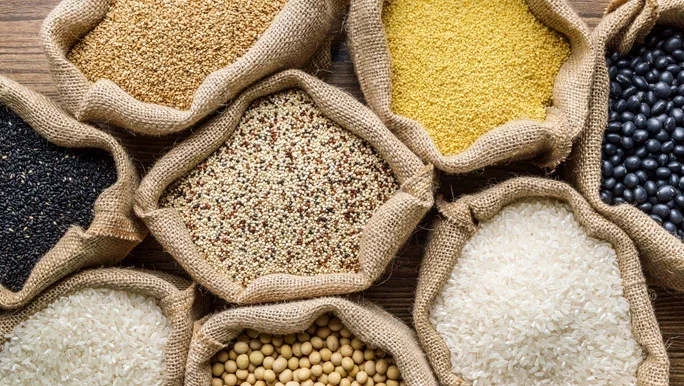Grain-based products are one of the first food groups that are blamed for triggering digestive symptoms including bloating and diarrhoea. As a result, more and more people are unnecessarily eliminating carbohydrates and restricting gluten-containing products from their diet. Even if you find you don’t tolerate some grains, it’s likely that certain types and quantities of grains can still be included in your diet. Here we will be focusing on low FODMAP grains and, in particular, how important they are to remain in your diet.
FODMAPs in grain-based foods
The main group of FODMAPs found in grain-based products are sugars belonging to the oligosaccharide family including fructans and galactooligosaccharides. Universally, these sugars are poorly digested in the small intestine. As a result, they undergo fermentation by our gut bacteria in the large intestine. Thus, those diagnosed with IBS may find eating grain-based products even more problematic. But that doesn’t mean you need to cut them out of your diet.
There are low FODMAP grains that can be used as alternatives! Want more info on the FODMAP content of your favourite foods? Sign up for our FREE Simple FODMAP Challenge program.
But first… what are whole grains?
We hear a lot about whole grains, but what specifically are they?
Grains have three distinct components. The outermost layer of the grain is known as the ‘bran layer’, mostly made up of fibre containing protein and minerals. The ‘endosperm’ is the largest component of grains as it is the storage site of the starch granules. Inside grains is a nutrient-rich core known as the ‘germ’, which contains all the essential nutrients.
As shown on the left, wholegrains refer to grains that have all these three layers intact. These grains are rich in carbohydrates, protein, fibre, vitamins and minerals i.e. ‘nutrient-dense.’ However, when grains undergo food processing such as milling, the two most important layers of the grain are removed. These ‘refined grains’ are the main component of white grain-based products including white bread and pasta which are more energy-dense.
The importance of whole grains
1. Fibre
The diverse microbiota living inside your gut requires fibre as its only source of fuel to survive. You should aim to feed your gut with 25-30g of fibre a day to ensure its proper bowel functioning and to reduce the risk of chronic diseases including cancer and Type 2 Diabetes. Grain-based products including bread and cereals make up 45% of our fibre intake and the remaining comes from the consumption of fruit and vegetables (National Nutrition Survey 1995). By consuming more wholegrain foods as part of your diet you could be providing your gut with over 50% of its fibre requirements.
2. Weight management
Have you ever had breakfast and then a few hours later felt hungry again? This may have been because there were no grains. Due to the high fibre content of whole grains, they keep you fuller for longer which aids with weight management. This is clearly stated in the National Institute for Clinical Excellence (NICE) guidelines. They recommend basing meals on wholegrains and eating plenty of fibre-rich foods for healthy weight maintenance. Various studies have also found high intakes of whole grains (three servings per day) being associated with lower BMI and central adiposity.
Low FODMAP grains to include in your diet
Oats (whole, oatmeal, oat bran)
- Porridge: Mix 1/3 cup of rolled oats with 1/3 cup almond milk, 1/3 cup lactose-free yoghurt, 1/3 cup berries and 2 teaspoons of rice malt syrup.
- Pancakes: Mix ½ cup rolled oats with 1/3 cup rice flour. Then add 1 egg, 1 unripe banana, 100ml of lactose-free milk and ½ tsp of cinnamon. Cook in batches on a shallow pan with some butter till golden.
- Protein balls: Combine ½ cup of rolled oats with ½ cup of almonds, 2 tablespoons cacao powder, 6 dates, ¼ cup chia seeds and 2 tablespoons of water. Roll into balls and refrigerate.
Quinoa (grain, flakes, flour, pasta)
- Salads: Toss boiled quinoa grains into all your favourite salads.
- Pasta: Use quinoa pasta as an alternative to white pasta when making any pasta dish
- Fritters: Combine 1/3 cup quinoa flour with 1 egg, 2 cups of shredded sweet potato, canned tuna and some herbs for a simple lunch.
Buckwheat
- Bread: Combine 2 cups of buckwheat flour with 1 tsp with gluten-free baking powder, 1½ cups of Greek yoghurt, 1 tbs of water and 2 tablespoons of olive oil to make a soft dough. Roll out the dough on baking paper, cook till golden and enjoy as an alternative to bread.
- Salads: Incorporate boiled buckwheat with roasted vegetables to make a warm salad
- Soups: Add buckwheat to any soup making it more satisfying
Rice (brown)
- Side dish: Use brown rice with a stir-fry or curry
- Salad: Incorporate some brown rice as the base of a refreshing salad bowl
Millet
- Porridge: Use millet as an alternative to oats in a breakfast dish
- Patties: Add some boiled millet instead of breadcrumbs to form crispy patties
Take some time experimenting with these low FODMAP alternatives and seeing how much you can tolerate. Men and women aged 19-50 years should aim for 6 serves of grains a day. A serve of grain is simply 1 slice of bread or ½ a cup of rice/ quinoa/ pasta/ buckwheat or ½ cup of cooked porridge.
Start today and incorporate low FODMAP grains into your diet. You will feel the benefits!
Need help with the low FODMAP diet? Our FREE dietitian developed program will guide you through it, step-by-step. Includes a low FODMAP food guide. Sign up now.
If you are experiencing gut symptoms and have not been recommended a low FODMAP diet by a health professional, get started with the manage your gut symptoms program.
Reviewed by the healthylife Advisory Board March 2022
